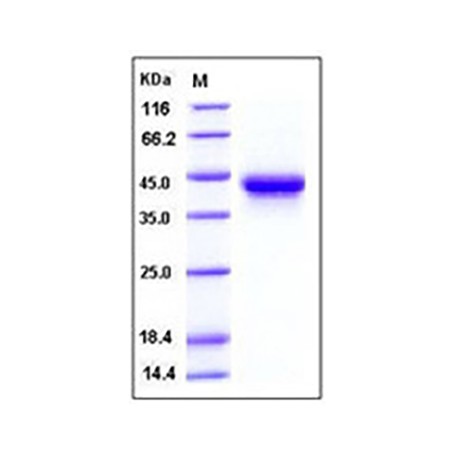No products
Product successfully added to your shopping cart
There are 0 items in your cart. There is 1 item in your cart.
Proteins and Enzymes
- Protein Control Ligand
- Pathway Inhibitors
- Function Modulators
- Activators
- G Protein-Coupled Receptor Ligands
- Nuclear Receptor Ligands
- GDNF Receptors
- TNF Receptors
- Transcription Factors
- Chemokines
- Cytokine Receptors
- Biomarkers and Buffer Solutions
- Molecular Probes
- Stem Cell Research
- Alzheimer's Disease
- Apoptosis
- Cancer Research
- Epigenetics
- Metabolites
- PET/SPECT Imaging Precursors
- Customized Screening Library
- Ultra Pure Pharmacological Standard
- Tissue Microarray (TMA)
- Proteins and Antibodies
- Primary Cells
- ELISA KIT
- Natural Products
- Lab Equipments
- Humanized Mice for PDX Platform
- Rare Chemicals
- Custom Synthesis
- Antibacterial
- Antifungal
- Antioxidant
- Antiviral
- Molecular Glues
- PROTAC Linker
- SARS-CoV
 View larger
View larger Human IL2Ra / CD25 Protein (His Tag)
10165-H08H
Activity: (1) Using the Octet RED System, the affinity constant (Kd) of Human IL2RA-his (Cat:10165-H08H) bound to Human IL2 was 35nM. (2) Measured by its ability to inhibit IL2-dependent proliferation of MO7e human megakaryocytic leukemic cells in the presence of 30 ng/mL of recombinant human IL-2. The ED50 for this effect is 0.15-0.75μg/mL.
Please ask for quote for unit smaller than 1 mg
Molarity Calculation Cart®
HOW TO ORDER
Data sheet
| Molecular Weight | The recombinant human IL2Rα consists of 203 amino acids and has a predicted molecular mass of 23.3 kDa. In SDS-PAGE under reducing conditions, the apparent molecular mass of rhIL2Rα is approximately 44 kDa due to glycosylation. |
| Storage Condition | Samples are stable for up to twelve months from date of receipt at -70℃. Store it under sterile conditions at -20℃ to -80℃. It is recommended that the protein be aliquoted for optimal storage. Avoid repeated freeze-thaw cycles. |
| Purity | 97% as determined by SDS-PAGE |
More info
Protein Construction: A DNA sequence encoding the extracellular domainof human IL2 receptor α (NP_000408.1) (Met 1-Cys 213) was expressed with a C-terminal polyhistidine tag.
Reconstitution: A hardcopy of COA with reconstitution instruction is sent along with the products. Please refer to it for detailed information.
CD25 Background Information: CD25 (alpha-chain of IL-2 receptor, or IL2RA), is a type I transmembrane glycoprotein with a signal peptide, an extracellular region, a transmembrane region, and a cytoplasmic domain. IL2RA is expressed on activated T cells and regulatory T cells, and is capable of binding IL2 with low affinity by itself. However, a ligand-induced high affinity heterotrimeric receptor complex is produced when IL2RA is associated non-covelently with the IL2 receptor beta and gamma chain, and subsequently initiates the intacellular signal pathways such as MAPK or JAK/STAT. On dendritic cells (DC), CD25 has been previously regarded as an activation marker, while both murine and human DC can express CD25, they do not express the beta-chain of the IL-2 receptor, which is indispensable for the execution of IL-2 signaling. The IL2RA (CD25) gene is a substantial component of the high-affinity receptor molecule highly expressed by activated T lymphocytes. Recently, a strong evidence was obtained for the involvement of IL-2RA in conferring susceptibility to type 1 diabetes (T1D). Cancer growth and development is associated with the stimulation of the innate immune system, including enhanced interleukin 2 receptor (IL-2R) expression in immune cells and its shedding into the circulation in a soluble form of sIL-2Ralpha. In most haematological malignancies, including different types of leukaemias and lymphomas, sIL-2Ralpha has been found to be released directly from the surface of neoplastic cells thus reflecting the tumour bulk, turnover and activity. Several studies have proved that not only lymphoid cancer cells, but also some non-lymphoid cancer cells, express IL-2R on their surface. They include malignant melanoma and carcinomas of the kidney, head and neck, oesophagus and lung. Thus, sIL-2Ralpha is elevated in most proliferative disturbances of the hematopoietic system and in many solid tumors.
References:
- Driesen J, et al. (2008) CD25 as an immune regulatory molecule expressed on myeloid dendritic cells. Immunobiology. 213(9-10): 849-58.
- Olejniczak K, et al. (2008) Biological properties of interleukin 2 and its role in pathogenesis of selected diseases--a review. Med Sci Monit. 14(10): RA179-89.
- Chistiakov DA, et al. (2008) The crucial role of IL-2/IL-2RA-mediated immune regulation in the pathogenesis of type 1 diabetes, an evidence coming from genetic and animal model studies. Immunol Lett. 118(1): 1-5.
- Bien E, et al. (2008) Serum soluble interleukin 2 receptor alpha in human cancer of adults and children: a review. Biomarkers. 13(1): 1-26.

